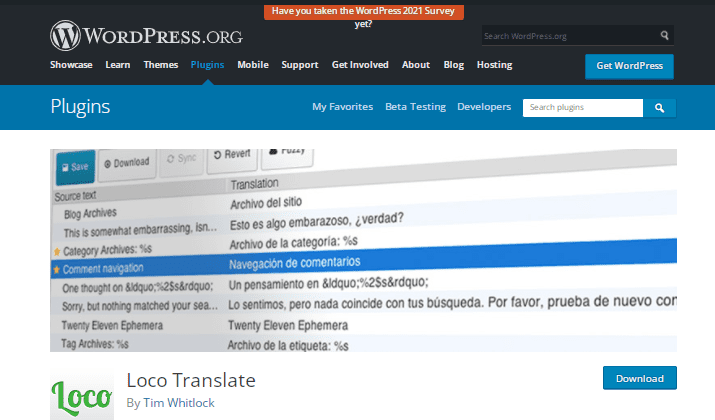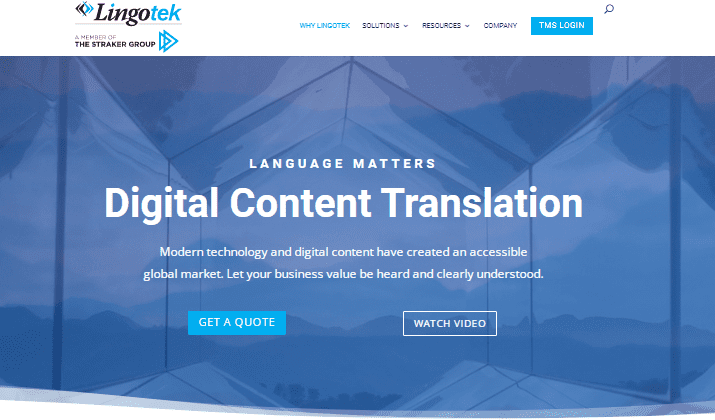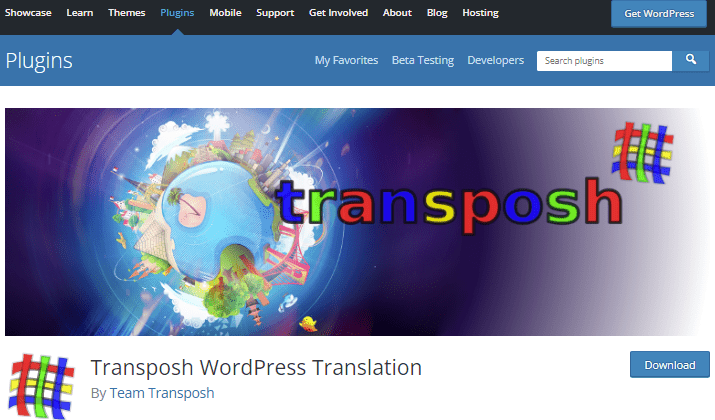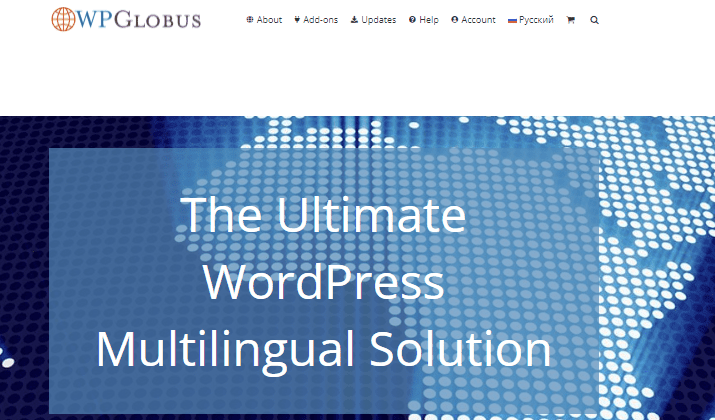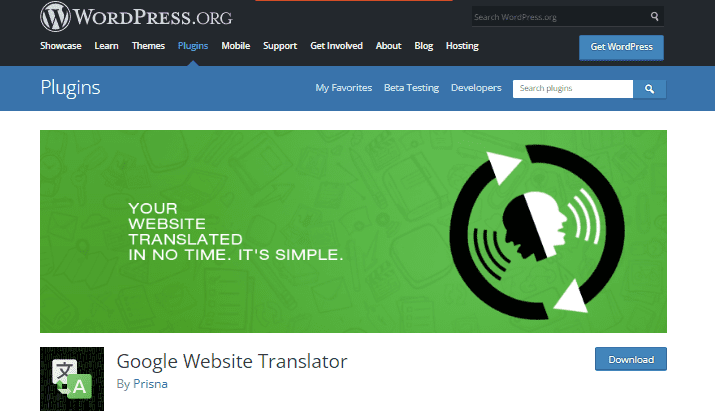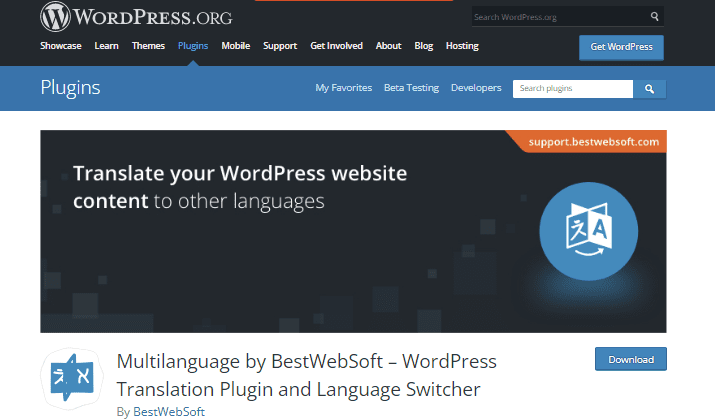WPML is a popular WordPress Plugin used for creating multilingual websites. It lets you translate content into various languages and run them smoothly on your sites.
With WPML, you can manage multiple language content within the same domain with just one WordPress installation. In this way, you’ll serve a diverse audience from one central place without installing WordPress on different domains.
Whether it’s taxonomies, theme text, menus for custom post types, WPML can work them all. If you can’t translate content manually, the plugin will hook you up with professional translators.
It also integrates with eCommerce solutions to establish a multilingual store.
However, WPML isn’t without shortcomings. It does not come with a free version or an automatic translation feature. It sometimes makes the administration of your WordPress backend slow because it designs extra tables within the database.
Although its human translation is robust, translating content manually takes up much time. Also, in case you need to uninstall this plugin, there will be some duplicated posts or pages in the WordPress environment.
WPML works with most WordPress themes, but not all of them. It is also a heavy plugin.
That’s why we’ve prepared these alternatives in case WPML doesn’t fit your needs.
Keep reading to discover the right one for your needs.
Top WPML Alternatives
1. Polylang
Polylang is another translation plugin for WordPress. It helps you translate content from within your WordPress dashboard.
It offers a free version, and three paid pricing plans, including a Pro Plan with more features and Lingotek integration at $99, a Polylang for WooCommerce Plant at $99, and a Polylang Pro for WooCommerce at $139.
It also integrates with Lingotek Translation for more features and a powerful translation management system. This allows you to automatically translate websites with machine translation, unlike when using WPML. You also get your own translators, and you can outsource your translations to expert services.
To use these extra services, you’ll need to install Lingotek. Polylang has an intuitive translation interface where you curate content first before translating it.
Its free version enables you to translate taxonomies, widgets, and other basic strings. With third-party extensions, you can also translate page builder content, custom fields, and more.
Polylang lets you choose from three URL structures to create translated content that is SEO-friendly. In addition, you get to use a different domain name for every translated version.
It works with Yoast SEO, links automatically to relevant URLs for categories, menu items, and adds hreflang attributes. However, you have to subscribe to the Pro version to translate the base slug for taxonomies and custom post types.
2. TranslatePress
TranslatePress is a WordPress translation plugin you can use for free. It offers automatic translation and neat front-end editing. It is entirely self-hosted, which means it uses more traditional WordPress billing.
Its premium plan offers unlimited translated content or page views. It allows you to use all three translation styles. The manual translation is the default translation style, but you can enable automatic translation in Google Translate using the Google Translate API key.
With the automatic translation option, you can only translate strings that haven’t been translated manually. This helps to avoid overwriting the manual projects. You are allowed to edit translations manually.
Using the Translator Accounts add-on, you can create dedicated translator accounts to manage your website’s front-end translations.
TranslatePress doesn’t have direct integration with professional translation services. It has its own unique translation method, with an interface similar to that of the real-time WordPress customizer.
The interface allows you to post content, edit widgets, theme strings, and more. You can also pick content from the Hestia custom page feature. And you can translate everything on your web page, including menu items, taxonomies, page builder content, URL slugs, WooCommerce products, theme, and plugin strings, among others.
It’s also good to know that, like other plugins, TranslatePress creates SEO-friendly content using the SEO Pack Add-on. It also allows you to use subfolders for languages. It can automatically change the menu and widget links to create a crawlable version of your already translated site.
This plugin also gives you the option to force rewrite in-content links into their respective languages automatically, unlike in WPML, where you have to do it manually.
With the SEO Pack Add-on, you can translate the page title set with Yoast SEO and description. URL slugs, image alt text, and Facebook open graph tags.
The TranslatePress plugin is listed at WordPress.org as a free tool. It also has paid pricing plans including the developer pack at 199 Euros/year, Business Plan at 139 Euros/year, and Personal Plan at 79 Euros/year.
3. Weglot Translate
Weglot focuses on human and automatic translation which you’re allowed to order through its dashboard.
Weglot has an external cloud interface that helps you manage translations away from your WordPress dashboard. Its billing is SaaS-style too.
To translate content using Weglot is automatic. The plugin uses machine translation to make things easier. You’ll only need to edit the translations manually by outsourcing them to expert translators. It has two editing interfaces on its website. You don’t need to use the WordPress dashboard.
The standard editor-style interface lets you view the original and translated content side by side. You can filter it by URL or view all your site’s translations. Weglot will let you know whether a human reviewed each translation or not.
The visual editor is neat, and you can click on strings on the live version of your site. When you click to edit a string, you are able to manage the translation in a live preview.
Weglot is designed in such a way that if you’re working as a team, you and your team can install it and run your multilingual projects together.
Within a very short time, the plugin can translate and display millions of words and include a customizable language switcher to your front website. No more tedious zip file uploads and downloads.
It centralizes your translation management on one user-friendly dashboard, including content from other platforms like WooCommerce, WPForms, Yoast, and more, media files, widgets, and SEO metadata. In other words, you don’t have to switch between interfaces.
With Weglot, you can translate everything on the front end of your website. It comfortably picks any content for translation. The plugin uses subdirectories to exclusively create a crawlable version of your site. It is SEO friendly and rewrites internal URLs automatically to link to their respective languages.
After installing Weglot, it automatically adds a language switcher to your site. However, WPML may require that you add a custom code or get a developer’s help to add the language switcher to the WordPress theme.
Since it operates on SaaS billing, you have to keep using it to preserve the translated version of your website. This way, you won’t lose transactions and the plugin will export them if you instruct it to.
Weglot offers a free 10-day trial and four more pricing plans including a starter plan at 9.90 Euros/month, Business Plan at 19 Euros/month, Pro Plan at 49 Euros/month, and Advanced Plan at 199 Euros/month.
4. Xili-language
Xili-language is available in the WordPress plugin repository. It contains more configuration options with useful alert boxes in the settings to familiarize yourself with the platform.
The plugin creates a post’s translation with its own ID. All the posts appear in the posts list by default. Taxonomies and categories are easy to translate using an extra plugin known as Xili dictionary.
You can use the plugin’s settings, API, and hooks to personalize the theme’s behavior with ease. It’s not easy to achieve the same with WPML.
It is a developer-friendly platform with API and a list of hooks to use for theme behavior personalization.
Xili-language has extensive documentation to help you in the process.
Also Read: Is WordPress Good For Ecommerce?
5. Loco Translate
Loco Translate is another popular translation plugin that offers in-browser editing of your WordPress content. It comes with integration support and various automatic translation options.
Loco integrates with various translation APIs including Microsoft, DeepL, Yandex, and Google. It also supports various keyboard shortcuts to help you maneuver and work faster.
It has an in-built translation editor to help make translations. You can create new translations and update the old ones here.
With this plugin, it’s easy to extract translatable strings from the source code. Its free plan can translate up to 2000 words every month.
Unlike WPML, Loco Translate comes with built-in WordPress locale codes.
Check Out: Duda vs WordPress
6. MultilingualPress
With MultilingualPress, you can create unlimited connections between sites. For instance, If your main website is in English, you can instruct MultilingualPress to link it up with various separate multisite installs for German or Spanish.
Despite the multiple installs, you don’t need to switch sites in order to edit your translations. The MultilingualPress interface allows you to edit your translations from the original post editor, allowing you the convenience you need.
Doing your translation this way is beneficial, especially when you’ll want to deactivate the plugin. Your already translated content will remain intact, which is what most translation plugins don’t offer. You’ll only lose the interface, but not the translated versions of your sites.
To translate content, MultilingualPress creates separate installs for every language using the WordPress Multisite. After that, it will provide you with a lightweight user interface that connects all these sites.
In contrast to WPML, there’s no lockin effect in MultilingualPress. In other words, even after deactivating it, all multi sites using the plugin will still work separately without garbage output or data loss.
Multilingual is SEO-friendly because Google can index your fully translated site easily. This plugin supports more than 174 languages.
Even if each translation is on separate sites, your themes and plugin settings will be synced across all the sites that are translated. MultilingualPress has a feature that carries out the syncing.
Ideally, MultilingualPress offers much flexibility compared to other tools. It has a free plan and premium pricing which includes the Standard Plan at $99, Pro Plan at $299, and Agency Plan at $599. It also has a Custom Enterprise Solution that is quote-based.
7. Lingotek Translation
Lingotek Translation isn’t a standalone translation plugin. This tool works with Polylang to complement it by offering much-needed language skills.
Lingotek is a high-end cloud-based translation network offering three different types of translation capabilities, which is something I haven’t seen in WPML.
The first machine translation is free and can translate up to 100,000 characters. The second one is a community translation that helps you translate content using the text editor from Lingotek.
The third service is the option to use Lingotek’s professional translation services. This will ensure you have top-rated translation quality.
To work with the Lingotek plugin, you have to create an account. The plugin will then transfer all the content you have to its servers for translation. It has a progress bar through which you can visualize the progress.
Once it is done with translation, your content will be transferred back to your website. The rest will be easy. You’ll be able to create media, categories, menus, widgets, pages, posts, post tags, and menus and specify the language for all of them.
Lingotek also allows you to use a separate domain or subdomain for every language. To make it easy for your audience, you can include a language switcher as a widget or in the menu. Customize your admin area with any language you prefer.
Pricing this plugin is available at a quote.
Explore: Easiest Ecommerce Website Builders
8. Transposh
Transposh has a translation engine that translates content automatically. It also has configuration screens with a clear and concise option to choose from.
Translations are available for every content. A link to the translated version appears in the form of a widget, which you can drag to your sidebar or widget area for display.
Translated content lives on the front end where you can carry out content editing. In the translation widget, there’s a checkbox that gives you the option to edit your content from the front end.
You can also translate and translate the menu, sidebars, and everything on your website automatically.
If you are looking for a plugin whose initial translation is automatic and editing is done on the front end, then Transposh is your tool.
Unlike WPML, Transposh allows website users to select already translated content directly from your website and add their own translation.
9. GTranslate
Translate relies on Google Translate’s automatic translation service. It translates your site into 104 languages, making your website accessible to up to 99% of internet users.
It includes both human and automated translations to help you carry out your translations with ease. After translation, it will hide the Google top frame as well as the suggestion that asks you if you need better translations.
GTranslate provides translation for posts, menus, tags, widgets, pages, categories, plugins, and themes. It also includes RTL support. Its floating language selector that lazyloads country flags is included too.
Menu items often carry country flags along so that WooCommerce shops are also fully translated.
The premium version of GTranslate ensures SEO. It helps to increase your site’s international reach. It also allows for manual editing of the translations while adding the in-context translation feature.
You’ll also get a subdirectory or subdomain URL structure, translate media, translate for AMP pages, and also Live Chat support.
What’s more, GTranslate displays the number of translations and translation traffic on your dashboard, a feature that’s lacking in WPML.
Translate has a 15-day free trial, a free version, and paid pricing which includes a Custom plan at $7.99, a Startup Plan at $17.99, a Business Plan at $27.99, and an Enterprise Plan at $37.99.
Explore: Best AliExpress WordPress Plugins For Dropshipping
10. WPGlobus
WP Globus lets you translate pages, tags, posts, widgets, menus, and categories manually. It has all the basic features you need to translate your site and manage your translations. It has a front-end language switcher and gives you the option to change the language on the interface from the top bar.
WPGlobus is part of a group of plugins that helps you turn your site into a multilingual, engaging website that reaches a broad audience base.
You can use it to add one or several languages to enable translating your content into various languages. It supports Yoast SEO and All-In-One SEO plugins to help you stay organized.
The plugin includes free addons that help you set featured images separately for every language. The addons integrate well with WPBakery Page Builder themes. They also impart multilingual editing capability to the tool’s visual editor widget.
To translate URLs, add language-specific keywords, translate WooCommerce, and more, you have to get premium add-ons.
Unlike WPML, which doesn’t have a free version, WPGlobus is always free with incredible features. But you can use paid addons to enjoy more features.
11. Google Website Translator
Google Website Translator is a free plugin supporting dynamic content translation into more than 100 languages. When you need to translate content, just choose the languages you want to offer and configure them in the translation drop-down. Your site visitors will start translating content into their preferred language.
With this plugin, you’ll be able to insert widgets in any sidebar or post. Your website visitors will interact with it to select their language by clicking the country flag or drop-down menu. In seconds, you’ll view content from your website in your preferred language.
You can exclude some parts of your site from translation if you want, something you can’t easily achieve with WPML. There are four options of widget styles available. Using the simple settings and inline editing, setup will be a breeze.
Once Google Website Translator is configured, you’ll be able to export your settings to other websites. This plugin doesn’t load external files, which makes it fast acting with no unnecessary CSS and JavaScript files.
12. Falang Multilanguage for WordPress?
Falang is an easy-to-set-up plugin that supports all the languages that WordPress supports (LTR and LTR). If you add a language in Falang, WordPress languages packages will automatically download and update.
This plugin is easy to use to translate your pages, posts, categories, menus, taxonomies, widgets, page builder content, custom fields, URL slugs, WooCommerce products, page title and description, theme and plugin strings, and more, whether linked from the WordPress interface or not.
The tool also lets you translate posts and terms permalinks, and additional plugins such as Yoast SEO, WooCommerce, and more.
It also integrates with Yandex for more enhanced translations. If your content is not translated, Falang will display the default language for the content. It has a configurable language switcher which you can include in the menu, sidebars, footer, or header.
With this plugin, you can translate your alt text, image captions, and various other media text translations without duplicating them. Its language code is directly in the URL and no extra database tables will be created, nor will there be content duplication.
While WPML is known to slow down a website when activated, activating Falang doesn’t impact your site speed or performance. Plus, the plugin is free to use.
13. Multilanguage by BestWebSoft
Multilanguage is another plugin that allows your website visitors to switch to their preferred languages and browse through content comfortably. It supports more than 80 languages and allows you to include new languages as you prefer.
Multilanguage has several language switch widgets for your visitors to select their convenient languages. You can also translate your site content manually if you want. The plugin will let you do this directly from your post editor.
Multilanguage has a simple and straightforward user interface that lets you work comfortably when translating your content. Its settings are simple, making it easier to set up than WPML.
Conclusion
Our winning WPML alternative is TranslatePress. It is an excellent option if your goal is simplicity and intuitiveness.
TranslatePress makes it effortless for you to manage all your translations. The best part is that the plugin works with all WordPress themes and plugins and you can work from a single interface.
With this plugin, you’ll be able to translate the whole website automatically, then manually refine your translations using its visual editor.
TranslatePress is a beginner-friendly plugin that helps you create multilingual sites without hassle. It is a great alternative to WPML and its free version will suffice and give you a fully functional multilingual site.
Tom loves to write on technology, e-commerce & internet marketing. I started my first e-commerce company in college, designing and selling t-shirts for my campus bar crawl using print-on-demand. Having successfully established multiple 6 & 7-figure e-commerce businesses (in women’s fashion and hiking gear), I think I can share a tip or 2 to help you succeed.




